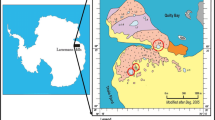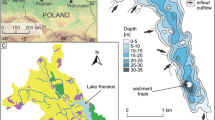Abstract
Stratigraphy of diatoms and chemistry in the surface sediment deposited at 35 m depth in Lake Polvijärvi was studied. The existence of annual laminations or varves in the sediment allowed a precise dating of the profile. Diatoms were analysed in 0.5 cm sequences; from 0 to 16.0 cm continuously and then intermittently every fourth 0.5 cm down to 44.0 cm. Sediment chemistry (loss-on-ignition, C, N, Fe, Mn, Mg, P, chlorophyll and carotenoids) was analysed from sediment surface down to 10.5 cm of altogether 33 subsamples, each containing 1–3 varves, and spanning the period 1921–1980.
From 4.5 cm depth upwards the diatom concentration strongly increases, and the plankton diatom succession from Tabellaria flocculosa through Asterionella formosa to Melosira ambigua and Fragilaria crotonensis reflects a marked eutrophication of the lake. This algal succession occurs in pace with an increase in sediment accumulation rate and changes in sediment chemistry, which indicate increased allochthonous inputs and enhanced algal production in the lake. The change of the lake ecosystem is contemporaneous with extensive peatland draining and fertilizing that was carried out on its watershed during the past two decades. Existing chemical data from a number of lakes situated within the drainage area prove that at present the treated peatlands are the main source of nutrient loading of Lake Polvijärvi.
A former period with indications of slightly increased productivity of the lake was dated by varve counting to AD 1690–1910 (35–12 cm). This period (characterised by Asterionella formosa) may coincide with that of the slash-and-burn cultivation in the area.
Similar content being viewed by others
References
Battarbee, R. W., 1978. Observations on the recent history of Lough Neagh and its drainage basin. Phil. Trans. r. Soc., Lond. 281: 303–345.
Battarbee, R. W. & Digerfeldt, G., 1976. Palaeoecological studies of the recent development of Lake Växösjön. 1. Arch. Hydrobiol. 77: 33–346.
Bengtsson, L., 1979. Chemical analysis. In Berglund, B. (ed.). Palaeohydrological changes in the temperate zone in the last 15 000 years: Lake and mire environments. Project guide, Lund: 113–132.
Bengtsson, L. & Persson, T., 1978. Sediment changes in a lake used for sewage reception. Pol. Arch. Hydrobiol. 25: 17–33.
Birks, H. H., Whiteside, M. C., Stark, D. M. & Bright, R. C., 1976. Recent paleolimnology of three lakes in Northwestern Minnesota. Quat. Res. 6: 249–272.
Brugam, R. B., 1978. Human disturbance and the historical development of Linsley Pond. Ecology 59: 19–36.
Edmondson, W. T., 1969. Cultural eutrophication with special reference to Lake Washington. Mitt. int. Ver. Limnol. 17: 19–32.
Favarger, P. Y. & Vernet, J. P., 1979. L'isotope 137Cs utilise comme dateur de la pollution des sédiments lacustres. Arch. Sci., Geneve 32: 25–42.
Gorham, E., 1964. Molybdenum, manganese and iron in lake muds. Verh. int. Ver. Limnol. 15: 330–332.
Gorham, E. & Sanger, J. E., 1972. Fossil pigments in the surface sediments of a meromictic lake. Limnol. Oceanogr. 17: 618–622.
Gorham, E. & Sanger, J. E., 1975. Fossil pigments in Minnesota lake sediments and their bearing upon the balance between terrestrial and aquatic inputs to sedimentary organic matter. Verh. int. Ver. Limnol. 19: 2267–2273.
Gorham, E. & Sanger, J. E., 1976. Fossilized pigments as stratigraphic indicators of cultural eutrophication in Shagawa Lake, northeastern Minnesota. Bull. geol. Soc. Am. 87: 1638–1642.
Granberg, K., 1972. The diatom succession in the recent sediments and the eutrophication of Ristiselkä, Lake Päijänne, Central Finland. Aqua Fenn. 1972: 20–27.
Håkanson, L., 1974. Mercury in some Swedish lake sediments. Ambio 3: 37–43.
Hansen, K., 1961. Lake types and lake sediments. Verh. int. Ver. Limnol. 14: 285–290.
Haworth, E. Y., 1972. The recent diatom history of Loch Leven, Kinross. Freshwat. Biol. 2: 131–141.
Heikurainen, L., 1960. Metsäojitus ja sen perusteet (The forest ditching and bases for it.). WSOY, Porvoo-Helsinki, 281 pp.
Heikurainen, L., 1967. Hakkuun vaikutus ojitettujen soiden vesitalouteen (On the influence of cutting on the water economy of drained peatlands.). Acta flor. fenn. 82: 39–45.
Huhma, A., 1975. Outokummun, Polvijärven ja Sivakkavaaran kartta-alueiden kalioperä (Precambrian rocks of the Outokumpu, Polvijärvi and Sivakkavaara map-sheet areas.). Geological map of Finland 1: 100 000. Explanations of mapsheets 4222 Outokumpu, 4224 Polvijärvi, 4311 Sivakkavaara. 1–151.
Huttunen, P. & Meriläinen, J., 1978. New freezing device providing large unmixed sediment samples from lakes. Ann. hot. fern. 15: 128–130.
Karsisto, K., 1970. Lannoituksessa annettujen ravinteiden huuhtoutumisesta turvemailta (Leaching of added nutrients from peatlands.). Suo 21: 60–66.
Kenttämies, K., 1980. The effects on water quality of forest drainage and fertilization in peatlands. IAHS-AISH Publ. 130: 277–284.
Koljonen, T. & Carlson, L., 1975. Behaviour of the major elements and minerals in sediments of four humic lakes in south-western Finland. Fennia 137: 1–47.
Meriläinen, J., 1969. Distribution of diatom frustules in recent sediments of some meromictic lakes. Mitt. int. Ver. Limnol. 17: 186–192.
Meriläinen, J., Huttunen, P. & Pirttiala, K., 1982. The effect of land use on the diatom communities in lakes. Hydrobiologia 86: 99–103.
Mortimer, C. H., 1941. The exchange of dissolved substances between mud and water in lakes. J. Ecol. 29: 280–329.
Nipkow, H. F., 1927. Über das Verhalten der Skelette planktischer Kieselangen im geschichteten Tiefenschlamm des Zürich- und Baldeggersees. Hidrol. Körl. (Z. Hydrol.) 4: 71–120.
Price, R. E. & Knight, Jr. L. A., 1978. Mercury, cadmium, lead and arsenic in sediments, plankton and clams from Lake Washington and Sardis Reservoir, Mississippi, October 1975 – May 1976. Pesticides Monitoring J. 11: 182–189.
Ravela, H., 1967. Metsäojituksen vaikutuksesta valuntaan (The effect of draining on runoff.). Suo 18: 56–60.
Ravera, O. & Parise, G., 1978. Eutrophication of Lake Lugano ‘read’ by means of planktonic remains in the sediment. Schweiz. Z. Hydrol. 40: 40–50.
Richards, F. A. & Thompson, T. G., 1952. The estimation and characterization of plankton populations by pigment analysis II. A spectrophotometric method for the estimation of plant pigments. J. mar. Res. 11: 147–155.
Round, F. E., 1964. The diatom sequence in lake deposits: Some problems of interpretation. Verh. int. Ver. Limnol. 15: 1012–1020.
Saloheimo, V., 1976. Pohjois-Karjalan historia II, 1617–1721 (History of North Karelia II.). Publ. Univ. Joensuu ser. A 6: 1–464.
Sanger, J. E. & Gorham, E., 1972. Stratigraphy of fossil pigments as a quide to the post-glacial history of Kirchner Marsh, Minnesota. Limnol. Oceanogr. 17: 840–854.
Särkkä, M., 1970. Metsälannoituksen vaikutus vesistössä (Effect of forest fertilization in water-courses.). Suo 21: 67–74.
Seuna, P., 1980. Long-term influence of forestry drainage on the hydrology of an open bog in Finland. IAHS-AISH Publ. 130: 141–149.
Simola, H., 1977. Diatom succession in the formation of annually laminated sediment in Lovojärvi, a small eutrophicated lake. Ann. hot. fern. 14: 143–148.
Simola, H., 1979. Micro-stratigraphy of sediment laminations in a chemically stratifying eutrophic lake during the years 1913–1976. Holarct. Ecol. 2: 160–168.
Simola, H. & Lodenius, M., 1982. Recent increase in mercury sedimentation in a forest lake attributable to peatland drainage. Bull. envir. Contam. Toxicol. 29: 298–305.
Vallentyne, J. R., 1955. Sedimentary chlorophyll determination as a paleobotanical method. Can. J. Bot. 33: 304–313.
Wahlen, M. & Thompson, R. C., 1980. Pollution records from sediments of three lakes in New York State. Geochim. cosmochim. Acta 44: 333–339.
Warwick, W. F., 1980. Palaeolimnology of the Bay of Quinte, Lake Ontario: 2800 years of cultural influence. Can. Bull. Fish. aquat. Sci. 206: 1–117.
Author information
Authors and Affiliations
Rights and permissions
About this article
Cite this article
Simola, H. Limnological effects of peatland drainage and fertilization as reflected in the varved sediment of a deep lake. Hydrobiologia 106, 43–57 (1983). https://doi.org/10.1007/BF00016415
Received:
Accepted:
Issue Date:
DOI: https://doi.org/10.1007/BF00016415




